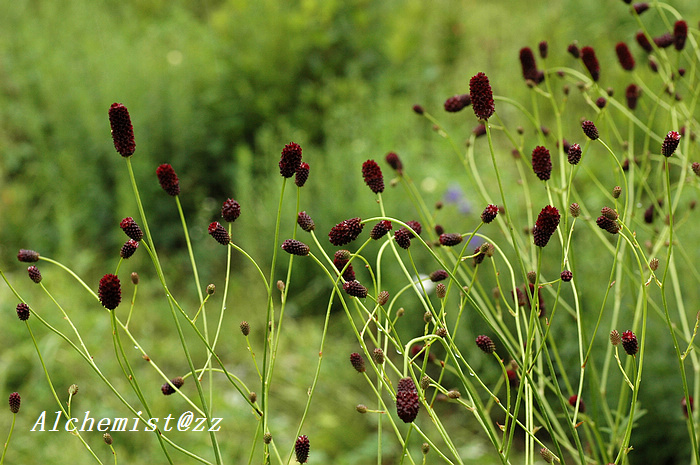- Scientific Name: Sanguisorba officinalis L.
- Ref: Sp. Pl. 1:116. 1753
- Synonyms: Pimpinella officinalis (L.) Lam., Poterium boreale Salisb., P. officinale (L.) A.Gray, P. officinale (L.) F.B.Forbes & Hemsl., Sanguisorba altissima Moench, S. andersonii G.Don, S. auriculata Scop., S. baicalensis Popl., S. bracteosa Besser ex Eichw., S. carnea Fisch. ex Link, S. cernua Besser, S. cordifolia Opiz, S. cylindrica Charb., S. glandulosa Kom., S. hispanica Mill., S. komaroviana Nedol., S. major Gilib., S. media L., S. menziesii Rydb., S. microcephala C.Presl, S. montana Jord. ex Boreau, S. officinalis var. globularis (Nakai ex T.Kawamoto) W.Lee, S. officinalis subsp. microcephala (C.Presl) Calder & Roy L.Taylor, S. officinalis f. pilosella (Ohwi) H.Hara, S. praecox Besser ex Rchb., S. rubra Schrank, S. sabauda Mill., S. serotina Jord., S. taurica Juz., S. unsanensis Nakai
- English Common Name: great burnet
- Chinese Common Name: 地榆 dìyú
- Japanese Common Name: ワレモコウ [吾亦紅/吾木香/吾妹紅] waremokō
- Family: Rosaceae
- Genus: Sanguisorba
- Distribution: Thinned forests, forest margins, thickets, meadows, grasslands, grassy mountain slopes, damp places in ravines, stream banks; near sea level to 3000 m. Anhui, Gansu, Guandong, Guangxi, Guizhou, Hebei, Heilongjiang, Henan, Hubei, Hunan, Jiangsu, Jiangxi, Jilin, Liaoning, Nei Mongol, Qinghai, Shaanxi, Shandong, Shanxi, Sichuan, Taiwan, Xinjiang, Xizang, Yunnan, Zhejiang [Asia, Europe].
- Photo: 08/17/2016, Mt. Changbai, Jilin
Herbs perennial, 30–120 cm tall. Rootstock brown or purple-brown, robust, usually fusiform, rarely terete, cross section yellow-white or purple. Stems erect, angular, glabrous, or base pilose or sparsely glandular hairy. Radical leaves: stipules brown, membranous, glabrous or abaxially sparsely glandular hairy; petiole long, glabrous or sparsely glandular, base sheathing and imbricate, sometimes sparsely glandular hairy; leaf blade with 4–6 pairs of leaflets; leaflets petiolulate, green on both surfaces, ovate, oblong-ovate, fasciated oblong, or fasciated lanceolate, 1–7 × 0.5–3 cm, base cordate to broadly cuneate, margin coarsely obtusely or rarely acutely serrate, both surfaces glabrous or abaxially sparsely pilose; cauline leaves: stipules large, semiovate, herbaceous, margin acutely serrate; leaflets shortly petiolulate or sessile, oblong to oblong-lanceolate, base subcordate to rounded, apex acute. Inflorescences erect, spicate, ellipsoid, cylindric, or ovoid, usually 1–6 × 0.5–1 cm, flowering from apex to base; rachis glabrous or occasionally sparsely glandular hairy; bracts lanceolate, shorter than or nearly equaling sepals, membranous, abaxially pilose, apex acuminate to caudate. Sepals 4, purple, red, pink, or white, elliptic to broadly ovate, abaxially pilose, with faint longitudinal midvein, usually with shortly acute apex. Stamens 4; filaments filiform, 0.5–1 × as long as sepals, exserted beyond them or not. Ovary glabrous or puberulous; stigma dilated, discoid, margin fimbriate-papillate. Fruiting hypanthium longitudinally 4-ribbed. Fl. and fr. Jul–Nov. (Flora of China)
